 Taiwan's AUO (AU Optronics) was formed in 2001, by the merger of Acer Display and Unipac Optoelectronics. Later in 2006 AUO merged with Quanta Display. AUO is one of the world's largest producers of LCDs.
Taiwan's AUO (AU Optronics) was formed in 2001, by the merger of Acer Display and Unipac Optoelectronics. Later in 2006 AUO merged with Quanta Display. AUO is one of the world's largest producers of LCDs.
In 2006 AUO became the world's first AMOLED producer but in 2007 the company decided to shift focus back to LCD, and stopped investing in OLEDs.
In January 2008 AUO resumed their OLED operation, and after years of development the company started mass producing AMOLEDs again in 2014 at its AFPD fab in Singapore. Over the years AUO developed several innovative OLED technologies such as flexible and bendable panels, transparent OLEDs, OLED lighting, OLED TV panels, inkjet printing and more. In recent years, AUO has shifted its focus to microLED display technology as it cannot compete with leading OLED producers. The company, according to reports, may shut down its AMOLED AFPD fab and convert it to microLED production.
No. 1, Li-Hsin Rd. 2
Hsinchu Science Park
Hsinchu, 30078
Taiwan
Will Apple invest in AUO to help it become a major AMOLED producer?
Reports that Apple has decided to adopt OLEDs in the 2018 iPhone models has been around for a while, and most of them concluded the Apple will sign OLED supply agreements with both Samsung and LG. A new report from Taiwan suggests that Apple plans to invest in AU Optronics, and help it become a leading OLED producer.
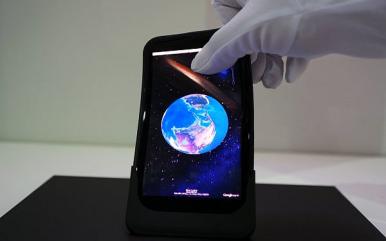
AUO declined to comment on those rumors, but shares in the company jumped over 5% in Taiwan's stock exchange.
OLED-A says 2015 was a great year for the OLED industry, gives interesting projections for 2016
The OLED Association posted an interesting article, summarizing 2015 and giving its projection for 2016 and onwards. So first of all, they conclude that 2015 was a great year for the OLED display industry, with shipments up 53% over 2014 to reach almost 275 million units. AMOLED Revenues grew to almost $13 billion - up 40% over 2014.
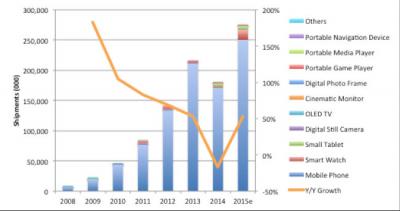
The growth was mostly due to Samsung Display's effort to commercialize flexible OLED displays for mobile phones and the expansion of AMOLED customer beyond Samsung Electronics. LG Display also contributed to the OLED display market, and the OLED association estimates the LG sold over 400,000 OLED TVs. They also say that they shipped around 14,000 flexible OLEDs, but they probably mean around 14 million - as that about makes sense for the Apple Watch.
An interview with Idemitsu Kosan's electronic material's chief
 Idemitsu Kosan is a large multinational Chemical company based in Japan that is supplying OLED materials for OLED producers. Idemitsu has OLED business units in Japan, Taiwan, Korea and China and is collaborating with UDC, LGD, AU Optronics, Doosan and others.
Idemitsu Kosan is a large multinational Chemical company based in Japan that is supplying OLED materials for OLED producers. Idemitsu has OLED business units in Japan, Taiwan, Korea and China and is collaborating with UDC, LGD, AU Optronics, Doosan and others.
Hajime Nakamoto, the head of the Electronic Materials Department at Idemitsu was kind enough to answer a few questions we had. Mr. Nakamoto joined Idemitsu in 1984 and has been involved with OLEDs since 2007.
Q: Hajime, Thank you for your time. Idemitsu has been one of the leaders in OLED materials for a very long time. Can you tell us what kind of materials you currently offer for OLED panel makers?
Idemitsu offers almost all kinds of OLED materials to OLED panel makers. Idemitsu is particularly well-known for its fluorescent blue host and dopant materials and transport materials, which offer advantages to OLED panel makers.
Apple opened a new display laboratory in Taiwan to develop new display technologies
According to Bloomberg, Apple opened a new laboratory in Taiwan where 50 engineers are developing new display technologies. Apple aims to develop new iPhone and iPad screens that are thinner, lighter, brighter and more energy efficient. Bloomberg says that Apple is focused on better LCDs - but is also "keen" to move to OLED displays.
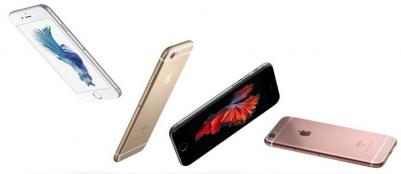
Apple moved in earlier in 2015, and the building was previously used by Qualcomm to develop Mirasol displays. The researchers and engineers were recruited mostly from AU Optronics and Qualcomm.
Former AUO executives found guilty of leaking OLED trade secrets to china's CSOT

 In October 2012 we reported that Taiwan's AU Optronics is suing two former executives that allegedly stole technologies (including AMOLED related ones) from the company and supplied it China Star Optoelectronics Technology (CSOT, a subsidiary of TCL).
In October 2012 we reported that Taiwan's AU Optronics is suing two former executives that allegedly stole technologies (including AMOLED related ones) from the company and supplied it China Star Optoelectronics Technology (CSOT, a subsidiary of TCL).
Today we learned that those two executives were found guilty by the Hsinchu Court in northern Taiwan. Tsung-Yi Hsu, a former OLED R&D department manager at AUO was charged of leaking AMOLED manufacturing and Thin-Film Transistor (TFT) structure research findings to CSOT (where he was employed as the director of the R&D center). Hsu will be jailed six months and fined NT $180,000 (around $5,500 US). The prosecutors are still deciding whether Hsu can pay a fine instead of facing imprisonment.
UBI explains their views of the OLED TV industry, gives bullish OLED market forecasts
During the OLED World Summit, an analyst from UBI gave an interesting presentation, showing the company's view of the current status of the OLED TV industry, and their OLED market forecasts for upcoming years.
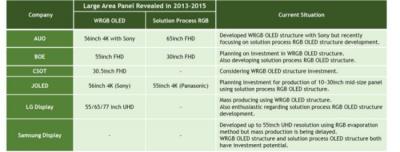
So first of all, we have LG and Samsung. LGD has obviously been successful in launching WOLED OLED TVs, and scaling up to mass production has been achieved. LG is also hopeful that solution processing will enable them to produce RGB-structured OLEDs efficiently. LG is collaborating with Merck and Espon on printing technologies.
This is AUO's 5" bendable AMOLED prototype
A few days ago AU Optronics announced that it will unveil a new 5" bendable AMOLED prototype with an integrated touch sensor, and today we have more details and a photo of this interesting AUO prototype.

The new panel is a 5" 720p (295 PPI) AMOLED display on an LTPS backplane. The frontplane is a top-emission AMOLED and the substrate is a plastic film, encapsulated using a thin-film barrier film. The whole panel, including the "film-type" touch sensor, is 0.2 mm thick.
AUO to show a bendable AMOLED that detects manipulation
Tomorrow AU Optronics will unveil a new 5" bendable AMOLED prototype that integrates a sensor that can detect when user bend the panel. The idea that detecting the size and direction of the manipulation can help create a user interface that complements regular touch functions.
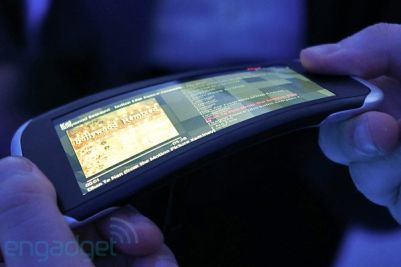 The 2011 Nokia Kinetic demonstrator
The 2011 Nokia Kinetic demonstrator
This is the first time we hear of an OLED display maker that is going to present such a prototype - but the idea is not new. Nokia demonstrated a similar device back in 2011 - the so-called Kinetic phone concept used a 4" OLED that was bendable, and bending the device could be used to select an option or zoom an image.
AUO unveils a 1.5" AMOLED panel for the wearable market
AU Optronics is focused on OLEDs for the wearable market, and is already producing 1.63" panels. AUO is also developing 1.4" and 1.3" circular AMOLEDs, and today the company demonstrated three OLEDs for the wearable market, including a new 1.5" square AMOLED (which you can see below, together with the 1.4" circular and the 1.63" square one).
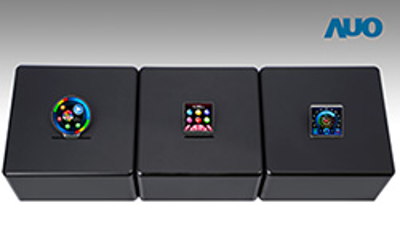
AUO is also producing 4.3", 5" and 5.5" AMOLED displays for mobile phones. Please contact us if you need help with finding a supplier for these new AMOLED displays.
Digitimes: China's AMOLED production capacity to grow 373% by 2017
Digitimes research estimates that small and medium AMOLED production capacity in China will grow 373% by 2017, which will establish China as the number two AMOLED producer behind Korea.

Currently the only Chinese AMOLED producers are Everdisplay, with a 4.5-Gen production line and Visionox which has recently started to produce panels in their 5.5-Gen fab. According to Digitimes, Taiwan's AU Optronics has a larger capacity AMOLED fab (which I'm not sure is true), but growth in China will surpass the growth in Taiwan.
Pagination
- Previous page
- Page 5
- Next page



